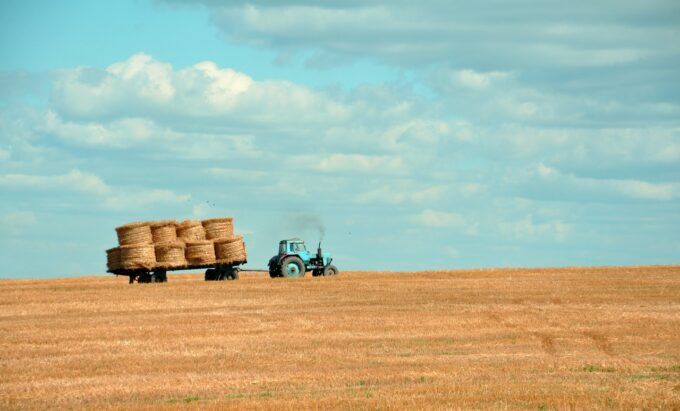Farm Adaptation Summit 2025 Unites Farmers, Businesses and Researchers to Rethink Resilient Food Systems – Green Queen Media

Report on the Farm Adaptation Summit 2025
Introduction: Aligning European Agriculture with the Sustainable Development Goals
The Farm Adaptation Summit 2025, hosted by the Farm Adaptation Network (FAN) in Copenhagen, convened over 50 stakeholders to address agricultural resilience in the face of climate, market, and dietary changes. The event focused on aligning the European food system transition with key Sustainable Development Goals (SDGs), particularly those concerning climate action, sustainable production, and economic stability for farmers. Participants from 11 nations, including Denmark, Sweden, Germany, and the UK, gathered to formulate strategies that support both environmental and economic sustainability, directly contributing to the 2030 Agenda for Sustainable Development.
Summit Objectives and Thematic Focus on SDGs
The summit’s agenda was structured to address critical challenges in European agriculture through the lens of the SDGs. Discussions centered on creating practical, farm-level solutions that advance global sustainability targets.
Core Thematic Areas
- SDG 2 (Zero Hunger) & SDG 12 (Responsible Consumption and Production): The summit emphasized a transition towards plant-rich production models and diversified agricultural systems. Pioneering farmers from Denmark and Germany presented case studies on shifting production to enhance food security and promote sustainable consumption patterns.
- SDG 8 (Decent Work and Economic Growth) & SDG 9 (Industry, Innovation, and Infrastructure): A primary focus was on improving farmer resilience through new income diversification strategies and viable, long-term business models. Sessions explored unlocking finance for adaptation and building supportive ecosystems for agricultural innovation.
- SDG 13 (Climate Action): The core objective of the summit was to build agricultural systems resilient to climate change. Discussions tackled the development of low-carbon transition models and adaptive farming practices to mitigate climate impacts.
- SDG 17 (Partnerships for the Goals): The event exemplified a multi-stakeholder approach, bringing together farmers, research institutions (ETH Zürich, University of Bremen), NGOs (Organic Denmark), and major corporations (Oatly, Rewe Group) to foster collaboration essential for achieving sustainable development.
Key Outcomes and Strategic Initiatives
The summit produced tangible outcomes and launched several initiatives aimed at accelerating farm adaptation across Europe, reinforcing the commitment to the SDGs.
Launch of the European Strategic Blueprint for Farm Adaptation
A significant outcome was the launch of the initial phase of the European Strategic Blueprint for Farm Adaptation. This strategic document maps existing barriers and proposes solutions to accelerate the adoption of resilient and sustainable agricultural practices throughout Europe, providing a clear framework for policy and investment aligned with SDG 13 and SDG 2.
New Country-Specific Initiatives
Building on the summit’s momentum, FAN announced the advancement of new national programs designed to implement sustainable transition models at a local level:
- The Great British Plant-Rich Plan (UK): This initiative will develop a national framework to support farmer diversification into plant-rich models, directly contributing to SDG 12 and SDG 15 (Life on Land).
- Path to Plant Profits (Denmark): A pilot program focused on creating and testing finance models for low-carbon agricultural transitions, addressing the financial barriers to achieving SDG 13.
- Adaptation in Action (France): This program will showcase farm-level innovation and provide training for agricultural advisers in diversification strategies, fostering the knowledge-sharing required for SDG 9.
Conclusion: A Framework for a Just and Sustainable Agricultural Transition
The Farm Adaptation Summit 2025 successfully established a collaborative platform for advancing a farmer-led transition towards a resilient and sustainable European food system. By placing the Sustainable Development Goals at the core of its discussions and outcomes, the summit highlighted the necessity of integrated strategies that support environmental stewardship, economic viability, and climate resilience. The ongoing initiatives underscore a commitment to turning collaborative dialogue into concrete actions that keep farmers central to achieving the 2030 Agenda.
Analysis of Sustainable Development Goals in the Article
1. Which SDGs are addressed or connected to the issues highlighted in the article?
-
SDG 2: Zero Hunger
The article focuses on promoting sustainable agriculture and ensuring the resilience of farmers. It discusses the need to build “agricultural systems that are both environmentally and economically resilient” and supports a shift towards “plant-rich and diversified food systems,” which are central themes of SDG 2’s aim to end hunger, achieve food security, and promote sustainable agriculture.
-
SDG 8: Decent Work and Economic Growth
The economic viability of farming is a key issue. The article addresses the need for “economically resilient” farming and discusses “new income diversification strategies” and the creation of “business models that actually work in the long run.” This aligns with SDG 8’s goal of promoting sustained, inclusive, and sustainable economic growth and productive employment.
-
SDG 12: Responsible Consumption and Production
The summit’s focus on “rethinking production around plant-rich models” directly relates to sustainable production patterns. The involvement of major food businesses like Oatly and Rewe Group in discussions about scaling markets for plant-based proteins indicates a shift in both production and consumption, which is a core component of SDG 12.
-
SDG 13: Climate Action
The central question of the article is how farmers can “stay resilient as climate, markets, and diets continue to shift.” The event is named the “Farm Adaptation Summit,” and its goal is to accelerate “adaptation across Europe.” This directly addresses SDG 13’s call to take urgent action to combat climate change and its impacts by strengthening resilience and adaptive capacity.
-
SDG 17: Partnerships for the Goals
The article is built around the theme of collaboration. The Farm Adaptation Summit brought together a diverse group of “farmers, business leaders, and researchers” from 11 countries. The Farm Adaptation Network (FAN) itself is described as a partnership that “builds bridges across sectors” and connects “farmers, researchers, NGOs, and businesses,” embodying the multi-stakeholder approach championed by SDG 17.
2. What specific targets under those SDGs can be identified based on the article’s content?
-
Under SDG 2 (Zero Hunger):
- Target 2.3: Double the agricultural productivity and incomes of small-scale food producers. The article’s focus on “improving farmer resilience,” creating “new income diversification strategies,” and piloting “finance models for low-carbon transitions” in the “Path to Plant Profits” initiative directly supports increasing farmer incomes.
- Target 2.4: Ensure sustainable food production systems and implement resilient agricultural practices. The entire article is about this target, with mentions of building “environmentally and economically resilient” agricultural systems, fostering “resilient, sustainable agriculture,” and developing a “European Strategic Blueprint for Farm Adaptation.”
-
Under SDG 8 (Decent Work and Economic Growth):
- Target 8.2: Achieve higher levels of economic productivity through diversification, technological upgrading and innovation. The article highlights “farm innovation,” “diversification towards plant-rich production models,” and the development of new “business models that actually work,” which are all methods to increase economic productivity.
-
Under SDG 12 (Responsible Consumption and Production):
- Target 12.2: Achieve the sustainable management and efficient use of natural resources. The shift towards “plant-rich models” and “diversified food systems” is a strategy for more sustainable and efficient use of land and water resources compared to traditional livestock-heavy systems.
-
Under SDG 13 (Climate Action):
- Target 13.1: Strengthen resilience and adaptive capacity to climate-related hazards. The summit’s name and purpose, “Farm Adaptation Summit 2025,” and the goal of the Farm Adaptation Network to “future-proofing farmers in the agricultural transition” are explicitly aimed at building adaptive capacity to climate shifts.
-
Under SDG 17 (Partnerships for the Goals):
- Target 17.17: Encourage and promote effective public, public-private and civil society partnerships. The summit is a prime example, bringing together farmers, private sector actors (Oatly, Compass Group), research institutions (ETH Zürich), and non-profits (FAN, Organic Denmark) to collaborate on solutions. The article states that FAN “builds bridges across sectors” to achieve its goals.
3. Are there any indicators mentioned or implied in the article that can be used to measure progress towards the identified targets?
While the article does not mention official SDG indicators, it implies several metrics that can be used to measure progress:
- Development of strategic frameworks: The launch of the “European Strategic Blueprint for Farm Adaptation” and the development of the “Great British Plant-Rich Plan” serve as indicators of progress in creating national and regional adaptation strategies (relevant to Target 13.1).
- Number of farmers and advisors trained: The “Adaptation in Action” initiative in France, which aims to “train advisers in diversification,” implies that the number of trained individuals is a key metric for scaling up sustainable practices (relevant to Target 2.4).
- Establishment of new financial models: The Danish initiative “Path to Plant Profits” aims to “pilot finance models for low-carbon transitions.” The number and success of such pilots can be an indicator of progress in unlocking finance for adaptation (relevant to Target 2.3).
- Number of multi-stakeholder partnerships and initiatives: The existence of the Farm Adaptation Network itself, the summit with participants from 11 countries, and the new country-specific initiatives (in the UK, Denmark, and France) are direct indicators of the formation of partnerships to achieve sustainable development (relevant to Target 17.17).
- Adoption of diversified production models: The core goal is to accelerate a “shift toward plant-rich and diversified food systems.” The number of farms or the total acreage transitioning to these models would be a direct indicator of progress (relevant to Targets 2.4 and 8.2).
4. Create a table with three columns titled ‘SDGs, Targets and Indicators” to present the findings from analyzing the article.
| SDGs | Targets | Indicators (Implied from the article) |
|---|---|---|
| SDG 2: Zero Hunger | 2.3: Increase incomes of small-scale food producers. 2.4: Implement resilient and sustainable agricultural practices. |
Number of farmers adopting diversified, plant-rich models; Number of new finance models piloted for low-carbon transitions (“Path to Plant Profits”). |
| SDG 8: Decent Work and Economic Growth | 8.2: Achieve higher economic productivity through diversification and innovation. | Number of new, viable business models developed for farmers; Number of farm innovation and diversification initiatives launched. |
| SDG 12: Responsible Consumption and Production | 12.2: Achieve sustainable management and efficient use of natural resources. | Growth in markets for plant-based proteins; Number of major food companies (e.g., Oatly, Rewe Group) participating in supply chain transition. |
| SDG 13: Climate Action | 13.1: Strengthen resilience and adaptive capacity to climate-related hazards. | Number of national and regional adaptation strategies developed (e.g., “European Strategic Blueprint for Farm Adaptation,” “Great British Plant-Rich Plan”). |
| SDG 17: Partnerships for the Goals | 17.17: Encourage and promote effective public-private and civil society partnerships. | Number of multi-stakeholder partnerships and collaborative events established (e.g., the Farm Adaptation Network, the Summit); Number of participating countries and organizations. |
Source: greenqueen.com.hk
What is Your Reaction?
 Like
0
Like
0
 Dislike
0
Dislike
0
 Love
0
Love
0
 Funny
0
Funny
0
 Angry
0
Angry
0
 Sad
0
Sad
0
 Wow
0
Wow
0


















































.jpg.webp?itok=0ZsAnae9#)





/environment-climate-change-and-health-(ech)/water-sanitation-hygiene-and-health-(wsh)/landfill-tuvalu-36092.tmb-1200v.jpg?sfvrsn=5c21fe40_1#)


















